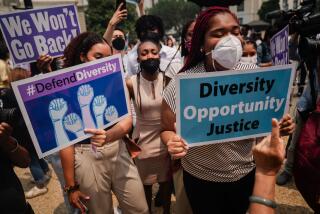Clinton Vows Heâll Fight to Retain Affirmative Action : Discrimination: The hurdle that the Supreme Court ruling raised âis not insurmountable,â President says. His action virtually assures a drawn-out battle over programs.
WASHINGTON â President Clinton vowed Tuesday to fight to preserve federal affirmative action programs that give preferences to blacks, Latinos and other minorities--a declaration that puts him at odds both with the Supreme Court and Republican leaders in Congress.
A day after the Supreme Court cast doubt on the legality of most such programs, Clinton said the court âhas raised the hurdle, but it is not insurmountable.â
âDespite great progress, discrimination and exclusion on the basis of race and gender are still facts of life in America. I have always believed that affirmative action is needed to remedy discrimination and to create a more inclusive society.â
By choosing to stand firm, the President virtually assures a drawn-out battle in the courts and Congress. That fight in turn will affect an already acrimonious debate in California, where voters may be called upon next year to decide the matter if an initiative derailing state affirmative action laws qualifies for the ballot.
The Supreme Court decision of Monday, as powerful as it is, does not automatically dismantle federal race-based preference programs. That can only be done through legislation or a series of supporting court rulings that come in response to specific lawsuits.
Rather, the justices simply declared that programs employing âracial classificationsâ generally are unconstitutional and they left it to lower courts to apply that strict standard in future cases.
The Administration had the choice of quietly acquiescing to the court opinion. But after nearly 24 hours of debate among themselves--following months of ruminating on the subject--White House officials have chosen to fight. The Justice Department will be responsible for defending federal affirmative action programs in court.
âIt is regrettable that already, with the ink barely dry, many are using the courtâs opinion as a reason to abandon that fightâ for affirmative action programs, Clinton said. âThe constitutional test is now tougher than it was, but I am confident that the test can be met in many cases.â
By contrast, Republican leaders said the ruling gives momentum to their drive to abolish racial preferences.
It is âone more reason for the federal government to get out of the race-preference business. . . . Itâs now our responsibility in Congress to follow the courtâs lead and put the federal governmentâs own house in order,â said Senate Majority Leader Bob Dole (R-Kan.), the front-runner for the Republican presidential nomination.
Mondayâs 5-4 decision came in the case of Adarand vs. Pena, involving a federal highway program that awarded a road repair contract to a Latino firm in Colorado that had submitted a slightly higher bid than a white contractor.
The high court declared that the Constitution makes âall racial classificationsâ by federal agencies âpresumptively invalid.â In rare instances, government can prefer some individuals over others but only if the preference is a ânarrowly tailored remedyâ for specific âprior discrimination,â not a broad-based government policy to redress societal inequities.
Writing for the court, Justice Sandra Day OâConnor suggested, however, that the government might adopt ârace-neutralâ policies that would help âsocially and economically disadvantaged individuals.â
Judges must now apply that ruling whenever a white person files a suit contending that he or she lost something--a job, a contract or a broadcast license, for example--because a federal agency gave preference to minority applicants. The ruling serves as a powerful indicator of the high courtâs leaning on the issue of affirmative action. But Supreme Court rulings, no matter how clear, are not self-executing.
For example, it took nearly a decade after 1954 before the unanimous ruling outlawing segregation began to open the school doors to black students in all parts of the South.
Critics of affirmative action, while cheered by Mondayâs opinion, also seemed resigned to a drawn-out battle.
âNothing will be swept aside overnight. It is very expensive and very time-consuming to challenge these programs,â said Richard Samp, legal director for the Washington Legal Foundation.
Evidence of continuing âmarketplace discrimination . . . is more than sufficientâ to prove that blacks and Latinos still need the benefit of special set-aside programs, said Anthony W. Robinson, president of the Minority Business Enterprise Legal Defense Fund.
Lawyers who have been through this battle before point to the 1989 ruling in Richmond vs. Croson. Then, OâConnor, also speaking for a 5-4 majority, ruled that state and local programs that give preferences to minorities may not stand unless they pass the same âstrict scrutinyâ test imposed on federal programs Monday.
Six years later, lawyers and government officials in California and around the country note that some local programs that reserved a percentage of contracts for minorities have been scrapped, but most have survived.
When the U.S. Supreme Court handed down the Croson ruling, âIt had an immediate impact,â said Deputy Los Angeles City Atty. Christopher M. Westhoff.
Before Croson, bidders had to meet numerical goals for women and minorities if they expected to win a contract from the city. After the Croson decision, the city dropped the numerical goals, but ordered up a study that would demonstrate a clear pattern of past discrimination, and began requiring contractors to make a good faith effort to hire minority- and women-owned subcontractors.
âAs a result . . . we saw a slight dip [in minority participation] but it wasnât great . . . ,â Westhoff said. A contractor subsequently challenged the requirement in court, forcing Los Angeles to suspend it for a year. But the California high court upheld the program in December.
Savage reported from Washington and Dolan from San Francisco.
More to Read
Get the L.A. Times Politics newsletter
Deeply reported insights into legislation, politics and policy from Sacramento, Washington and beyond. In your inbox three times per week.
You may occasionally receive promotional content from the Los Angeles Times.












